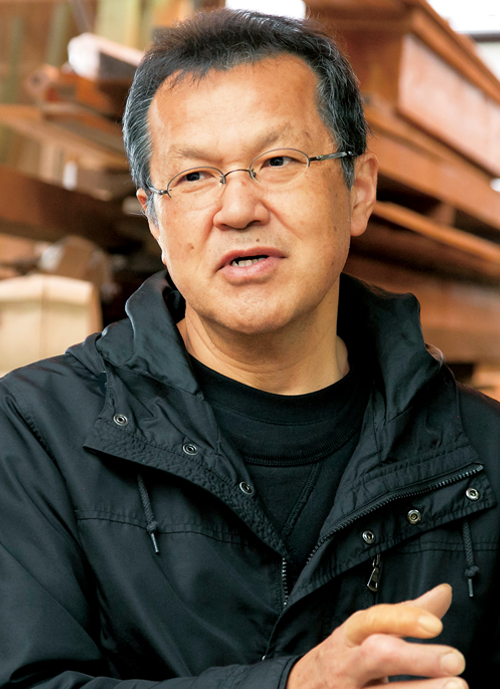—How do you feel about the potential of titanium in traditional architecture?
Mimura:
It has been only 70 years since titanium was industrialized. It is still young metal substance, while some shrines and temples are wooden buildings over 1,000 years old. That is why materials with a long track record are wanted. Although titanium is an excellent material, it takes a lot of courage to actually use. We can know that this project is a success only when someone declares “this titanium Rokuyo hardware is exceptional!” 100 or 200 years from now. At present, I still do not know whether this succeeds or not, but everybody tells me that the hardware is beautiful, which is a relief.
I am attempting to organize how to use titanium in my own way. We know from ancient wooden structures that wood tends to harden its cellular walls in 100 to 150 years, making it less likely to change shape. For this reason, when building a structure with new wood, it is better to use the weight of clay tiles to control this until the wood settles down. On the other hand, once 100 to 150 years have passed, the strength of wood gradually starts to weaken. Once this starts, it may be a good idea to change the roof tiles from clay to lighter titanium.
In recent years, artificial drying technologies has been progressing and wood building materials with large diameters have been reducing, so in some cases, using lightweight titanium roof tiles from the start may be better. If the roof is going to be made of titanium, why not use titanium for decorative hardware and the interior as well? I believe that adding titanium as a material choice, just like conventional materials such as copper, is an option.
—What are your future ambitions?
Mimura:
The periodical rebuilding of the Ise Shrine takes place every 20 years. I believe that carpenters who live and work within the shrine premises are qualified to be called as “Miyadaiku”. In modern day, daiku (carpenters) are known only as woodworkers, but heads of various professions used to be called daiku as well. Daiku used to be people who could consider and make decisions. During the ancient laws and ordinance system, they used to belong in the ranks of the Bureau of Carpentry or Office of Palace Repairs. The more I get to know the history of daiku, the more I believe that I still have not attained Miyadaiku status. One is eager to be called Miyadaiku when younger for some reason, without knowing that they are relying very much on the wisdom of our predecessors. Only relying on our forerunners, however, will not create new values. We need to dream about creating new things, or our industry will go to waste. I believe that creating new things in this way is the first step to add new values to the best of our ability to the techniques we have obtained from our predecessors and hand down the culture to the next generation.
The beams of a structure connect the past and present. As a master carpenter, it is my responsibility to identify what materials are good for that era and devise ways of using them to create something new. Recently more people have been visiting shrines and temples. There are many spectacular traditional structures in Kyoto and Nara, and important cultural properties in Onomichi and Miyajima in Hiroshima as well.
So then, how about the city you were born in? If local temples or shrines are beautiful, could people want to take care of their hometown more? In fact, there are many unique and high-quality structures around us. That is why I want to continue my efforts toward protecting Japanese tradition while adding a few new elements to hand down to the next generation, in this day and age.

The main shrine and worship hall of Takao Shrine
The shrine was constructed in the Kamakura period and moved to another location at the Eiroku era (1558 – 1570) at the end of the Muromachi period. The worship hall, offerings hall, and main shrine (rebuilt in 1933) were renovated in time for the October 2020 ceremony to celebrate 450 years since its relocation. The shrine is loved by locals as a god to ward off bad luck and bring in good fortune. Many visitors flock to the “Otafuku Torinuke,” an event held around Setsubun (the beginning of spring), in which a large mask of a woman is displayed and visitors can walk through her large mouth for good luck.










